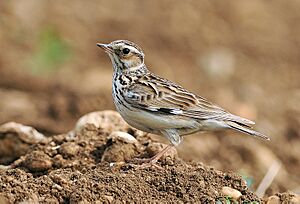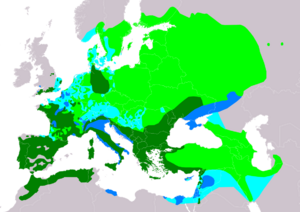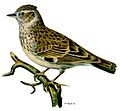Woodlark facts for kids
Quick facts for kids Woodlark |
|
|---|---|
 |
|
| Conservation status | |
| Scientific classification | |
| Genus: |
Lullula
|
| Species: |
arborea
|
| Subspecies | |
|
See text |
|
 |
|
| Range of L. arborea Breeding Resident Passage Non-breeding | |
| Synonyms | |
|
|
The woodlark (Lullula arborea) is a small bird that belongs to the lark family. It is the only living species in its group, Lullula. You can find woodlarks across most of Europe, the Middle East, and parts of Asia and North Africa. In western areas, they usually stay in one place all year. However, woodlarks from eastern regions travel south for the winter.
This bird is quite small, measuring about 13.5 to 15 centimeters long. That's about 20% shorter than its cousin, the skylark. Woodlarks are mostly brown with a lighter belly. They have a special white stripe above their eyes that meets at the back of their head. Their tail has white tips. Woodlarks mainly eat seeds, but they also enjoy insects when they are raising their young.
Contents
About the Woodlark
What's in a Name?
The woodlark got its scientific name, Alauda arborea, from a Swedish scientist named Carl Linnaeus in 1758. Later, in 1829, another scientist, Johann Jakob Kaup, placed it in a new group called Lullula. The name Lullula sounds like the bird's song, which is often described as "lu-lu-lu". The word arborea comes from Latin and means "tree," because these birds often live near trees.
Woodlark Family Members
There are two main types, or subspecies, of woodlarks:
- Northern woodlark (L. a. arborea): This type lives in northern, western, and central Europe, reaching as far as western Russia and Ukraine.
- Southern woodlark (L. a. pallida): This type is found in southern Europe, parts of North Africa, the Middle East, and areas like Iran and Turkmenistan.
How to Spot a Woodlark
The woodlark is a small bird, about 13.5 to 15 cm long. It is mostly brown on its back and pale underneath. A clear white stripe runs above its eye and meets at the back of its neck. It has a small crest on its head, but it's often hard to see.
When a woodlark flies, you'll notice its short tail and wide wings. The tail has white tips. Unlike the skylark, the woodlark's tail sides and wing edges are not white.
The Woodlark's Song
The woodlark is a songbird known for its beautiful, warbling song. People often describe it as a "lu-lu-lu" sound. It can also sound like "toolooeet toolooeet toolooeet." This lovely song is why its scientific name sounds like its call!
Where Woodlarks Live
Woodlarks are mostly found in Europe, the mountains of North Africa, and western Asia. They prefer open areas with scattered trees, like heathlands. They especially like clearings in pine forests and newly planted areas with young pine trees. Sometimes, they can even be seen in city areas, though this is rare.
In some places, like Britain, the woodlark's range has shrunk. It used to live in Wales and central England but is now mostly found only in southern England. Woodlark numbers can change a lot over the years.
Woodlark Life and Habits
Singing and Flying
Male woodlarks have a special song flight. They flutter and spiral upwards, singing as they circle above the ground. Both male and female woodlarks also sing from the ground or from a branch. They start singing early in the year, often around February in places like Britain.
Reproduction and Life Cycle
Woodlarks build their nests on the ground in a small dip. They use grass, roots, and moss to make it cozy. Nesting starts early, sometimes in March. A female woodlark usually lays three to five eggs. The eggs are whitish with brown speckles.
The female sits on the eggs for about 13 to 15 days to keep them warm. After the chicks hatch, both parents feed them. The young birds leave the nest when they are about 11 to 13 days old. Woodlark families often stay together through the summer and into the autumn. They can raise two, and sometimes even three, groups of chicks each year.
What Woodlarks Eat
Like many birds in the lark family, adult woodlarks mostly eat plants. Their diet is mainly made up of seeds. However, during the breeding season, they also eat medium-sized insects. These insects can include beetles, flies, and moths.
Challenges for Woodlarks
Woodlark populations have been decreasing in Europe. One big reason is habitat loss. Their natural homes, like dry grasslands and heathlands, are being lost. This happens because of farming, land being left unused, or new buildings being built. Wildfires have also harmed woodlark habitats in some areas.
Woodlarks in Culture
The woodlark has inspired poets! The poet Gerard Manley Hopkins wrote a poem called "The Woodlark." He tried to capture the bird's song using made-up words.
The Scottish poet Robert Burns also wrote about the woodlark's "melting art" in his poem "To the Woodlark." It's interesting because woodlarks are not usually found in Scotland. Some people think Burns might have been writing about a different bird, the tree pipit, which was sometimes called a woodlark in Scotland. However, woodlarks have been seen in Scotland sometimes, so it's possible he did hear one.
Woodlark Status
In 2004, there were an estimated 1.3 million to 3.3 million pairs of woodlarks breeding in Europe. Europe holds most of the world's woodlark population. Even though their numbers can change, the IUCN Red List of Threatened Species says the woodlark is of least concern. This means it is not currently at risk of disappearing.
Images for kids





